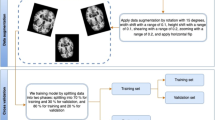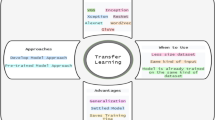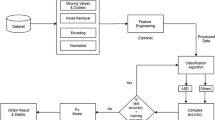Abstract
Autism spectrum disorders (ASD) is a neurodevelopmental disorder that causes repetitive stereotyped behavior and social difficulties, early diagnosis and intervention are beneficial to improve treatment effect. Although multi-site data expand sample size, they suffer from inter-site heterogeneitys, which degrades the performance of identitying ASD from normal controls (NC). To solve the problem, in this paper a multi-view ensemble learning network based on deep learning is proposed to improve the classification performance with multi-site functional MRI (fMRI). Specifically, the LSTM-Conv model was firstly proposed to obtain dynamic spatiotemporal features of the mean time series of fMRI data; then the low/high-level brain functional connectivity features of the brain functional network were extracted by principal component analysis algorithm and a 3-layer stacked denoising autoencoder; finally, feature selection and ensemble learning were carried out for the above three brain functional features, and a classification accuracy of 72% was obtained on multi-site data of ABIDE dataset. The experimental result illustrates that the proposed method can effectively improve the classification performance of ASD and NC. Compared with single-view learning, multi-view ensemble learning can mine various brain functional features of fMRI data from different perspectives and alleviate the problems caused by data heterogeneity. In addition, this study also employed leave-one-out cross validation to test the single-site data, and the results showed that the proposed method has strong generalization capability, in which the highest classification accuracy of 92.9% was obtained at the CMU site.








Similar content being viewed by others
Data availability
All data included in this study are available upon request by contact with the corresponding author.
References
Abraham A, Milham M, Martino AD et al (2016) Deriving reproducible biomarkers from multi-site resting-state data: An Autism-based example. NeuroImage 147:736
Chen Y, Keogh E, Hu B et al (2015) The UCR time series classification archive. www.cs.ucr.edu/~eamonn/time series data/
Craddock C, Benhajali Y, Chu C et al (2013) The neuro bureau pre-processing initiative: open sharing of preprocessed neuroimag-ing data and derivatives. Front Neuroinform 7:66
Di Martino A, Yan CG, Li Q et al (2014) The autism brain imaging data exchange: towards a large-scale evaluation of the intrinsic brain architecture in autism. Mol Psychiatry 19(6):659–667
Disorder American Psychiatric Association Autism Spectrum (2013) Diagnostic and statistical manual of mental disorders, 5th edition (DSM-5). American Psychiatric Publishing, Arlington, pp 50–59
Dvornek NC, Ventola P, Pelphrey KA et al (2017) Identifying autism from resting-state fMRI using long short-term memory networks. Mach Learn Med Imaging 10541:362–370
Dvornek NC, Ventola P, Combining Duncan JS (2018) Phenotypic and resting-state fMRI data for autism classification with recurrent neural networks. In: 2018 IEEE 15th international symposium on biomedical imaging (ISBI 2018). Proceedings of the IEEE international symposium on biomed imaging, p 725
Guo X, Dominick KC, Minai AA et al (2017) Diagnosing autism spectrum disorder from brain resting-state functional connectivity patterns using a deep neural network with a novel feature selection method. Front Neurosci 11:460
Hailong L, Parikh NA, Lili H (2018) A novel transfer learning approach to enhance deep neural network classification of brain functional connectomes. Front Neurosci 12:491
Heinsfeld AS, Franco AR, Craddock RC et al (2018) Identification of autism spectrum disorder using deep learning and the ABIDE dataset—ScienceDirect. NeuroImage Clin 17(C):16–23
Huang F, Tan EL, Yang P et al (2020) Self-weighted adaptive structure learning for ASD diagnosis via multi-template multi-center representation. Med Image Anal 63:101662
Kana RK, Uddin LQ, Kenet T et al (2014) Brain connectivity in autism. Front Hum Neurosci 8:349
Kang L, Jiang J, Huang J et al (2020) Identifying early mild cognitive impairment by multi-modality MRI-based deep learning. Front Aging Neurosci 12:206
Kang L, Chen J, Huang J et al (2022) Identifying epilepsy based on machine-learning technique with diffusion kurtosis tensor. CNS Neurosci Therap 28(3):354–363
Karim F, Majumdar S, Darabi H et al (2017) LSTM fully convolutional networks for time series classification. IEEE Access 99:66
Kazeminejad A, Sotero RC (2019) Topological properties of resting-state fMRI functional networks improve machine learning-based autism classification. Front Neurosci 12:66
Khan NA, Waheeb SA, Riaz A et al (2020) A Three-stage teacher, student neural networks and sequential feed forward selection-based feature selection approach for the classification of autism spectrum disorder. Brain Sci 10(754):66
Liu Y, Xu L, Li J et al (2020a) Attentional connectivity-based prediction of autism using heterogeneous rs-fMRI data from CC200 Atlas. Exp Neurobiol 29(1):66
Liu Y, Zou Yuting H, Jihong L (2020b) Current status of research on autism in children. Gen Pract Nurs 18(33):4584–4586
Lord C, Risi S, Lambrecht L et al (2000) The autism diagnostic observation schedule-generic: a standard measure of social and communication deficits associated with the spectrum of autism. JAutism DevDisord 30:205–223
Mehdizadehfar V, Ghassemi F, Fallah A et al (2020) Brain connectivity analysis in fathers of children with autism. Cogn Neurodyn 14(6):781–793
Muller RA, Shih P, Keehn B et al (2011) Underconnected, but how a survey of functional connectivity MRI studies in autism spectrum disorders. Cereb Cortex 21(10):2233–43
Rahman MM, Usman OL, Muniyandi RC et al (2020) A review of machine learning methods of feature selection and classification for autism spectrum disorder. Brain Sci 10(12):949
Rathore A, Palande S, Anderson JS, Features Autism Classification Using Topological, Deep Learning: A Cautionary Tale. In: Medical image computing and computer assisted intervention—MICCAI et al (2019) 22nd international conference, Shenzhen, China, October 13–17, 2019. Proceedings, Part III:2019
Ronicko J et al (2018) Diagnostic classification of autism using resting-state fMRI data and conditional random forest. In: Conference proceedings: annual international conference of the IEEE engineering in medicine and biology society. IEEE Engineering in Medicine and Biology Society. Annual conference
Sherkatghanad Z, Akhondzadeh M, Salari S et al (2020) Automated detection of autism spectrum disorder using a convolutional neural network. Front Neurosci 13:1325
Tiffany Kodak BDA, Samantha Bergmann BDB (2020) Autism spectrum disorder. Pediatr Clin N Am 6:66
Vincent P, Larochelle H, Lajoie I (2010) Stacked denoising autoencoders learning useful representations in a deep network with a local denoising criterion. J Mach Learn Res 10:3371–3408
Wang Z, Yan W, Oates T (2017) Time series classification from scratch with deep neural networks: a strong baseline. In: 2017 International joint conference on neural networks (IJCNN). IEEE, pp 1578–1585
Wang C, Xiao Z, Wu J (2019) Functional connectivity-based classification of autism and control using SVM-RFECV on rs-fMRI data. Phys Med 65:99–105
Wang Y, Wang J, Wu FX et al (2020) AIMAFE: autism spectrum disorder identification with multi-atlas deep feature representation and ensemble learning. J Neurosci Methods 343:108840
Wang N, Yao D, Ma L et al (2022) Multi-site clustering and nested feature extraction for identifying autism spectrum disorder with resting-state fMRI. Med Image Anal 75:102279
Werling DM, Geschwind DH (2013) Sex differences in autism spectrum disorders. Curr Opin Neurol 26(2):146
Yang HZ, Gui YE (2020) Exploring the effect of applying early care interventions for children with autism. Med Theory Pract 33(24):167–169
Acknowledgements
Funding was provided by National Natural Science Foundation of China (Grant Nos. 81960312, 62171287) and Science and Technology Planning Project of Shenzhen Municipality (Grant No. 20200821152629001).
Author information
Authors and Affiliations
Corresponding author
Ethics declarations
Conflict of interest
We declare that we have no financial and personal relationships with other people or organizations that can inappropriately influence our work, there is no pro-fessional or other personal interest of any nature or kind in any product, service and/or company that could be construed as influencing the position presented in, or the review of the manuscript.
Additional information
Publisher's Note
Springer Nature remains neutral with regard to jurisdictional claims in published maps and institutional affiliations.
Rights and permissions
About this article
Cite this article
Kang, L., Chen, J., Huang, J. et al. Autism spectrum disorder recognition based on multi-view ensemble learning with multi-site fMRI. Cogn Neurodyn 17, 345–355 (2023). https://doi.org/10.1007/s11571-022-09828-9
Received:
Revised:
Accepted:
Published:
Issue Date:
DOI: https://doi.org/10.1007/s11571-022-09828-9




